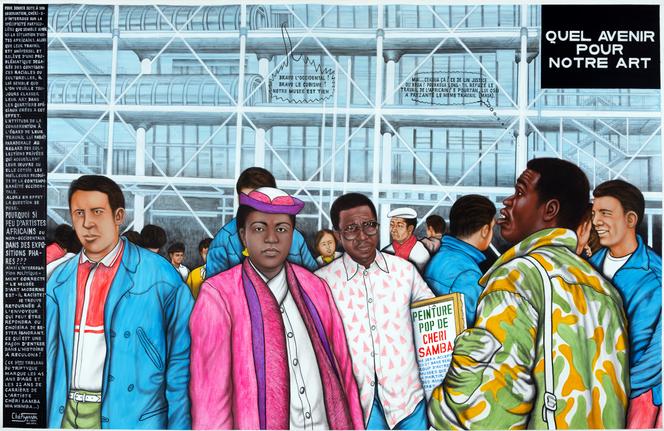


Today, Chéri Samba is a celebrated artist. He has taken part in many major collective shows: at Paris's Centre Pompidou, with "Magiciens de la Terre" (Earth Magicians) in 1989 and "Africa Remix" in 2005; at the Venice Biennale in 2007; at the Fondation Louis Vuitton in 2017. But his personal retrospectives are rare: The last in Paris, which was only his second, was held in 2004 at the Fondation Cartier. Yet it would be an understatement to say that the painter, born in 1956 in Kinto M'Vuila, Democratic Republic of Congo, occupies a remarkable place in today's art. The presentation of some 50 paintings at the Musée Maillol in Paris is a testament to his singularity and coherence. They belong to the French-Italian collector Jean Pigozzi, who has long been Samba's main fan.
Having moved to Kinshasa in 1972, he laid down the principles of his painting right from the start and has remained firmly attached to them ever since, the only perceptible developments being the progressive enlargement of formats and the extreme perfection of execution, up to and including virtuoso pieces. His first principle is to deal with all the subjects of everyday life, in the Congo and around the world, especially those that cause pain or fear. Gender inequality, racism, the memory of slavery and colonialism, poverty, the problems of water and pollution, epidemics that spread against a backdrop of ignorance, child soldiers, American imperialism, terrorism and corruption: It's hard to imagine what feature of contemporary humanity Samba could have omitted from his inventory.
They alternate between mocking satires of morals and merciless allegories of current affairs. Adultery and sexual desire are at the forefront of the former. The latter are divided between those dealing with international politics and war, on the one hand, and, on the other, those that expose the disdain with which Western cultural institutions treated the ancient arts of Africa and contemporary African artists until the end of the 20th century. His work is therefore central to the debate on appropriation, spoliation and restitution.
Setting himself such subjects, Samba knew at once that words would be as necessary to him as figures and colors. Starting with comic strips and signs, he transferred their processes to canvas: dialogues between characters, book pages, captions and comments in capital letters along the edges of the canvas. In English, French or Lingala, they render accessible what images cannot fully express. Samba does without them only when he deems that the pictures are explicit enough on their own and their symbolism easily accessible. Such is the case with his self-portrait in the form of a spiral garland, a paintbrush between his teeth, the title of which reads "J'aime la couleur" ("I Love Color").
You have 25% of this article left to read. The rest is for subscribers only.
